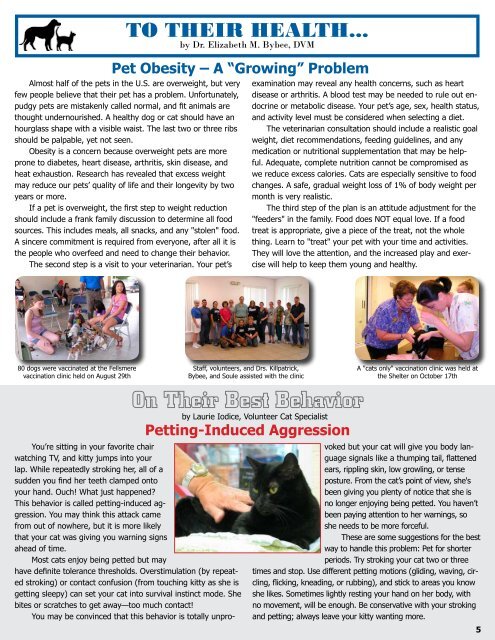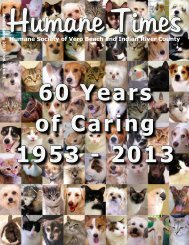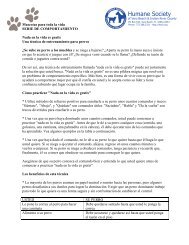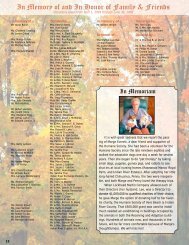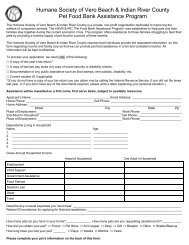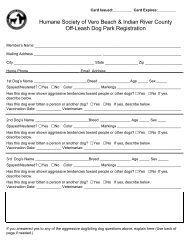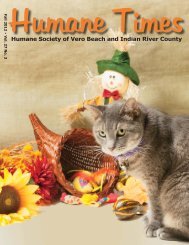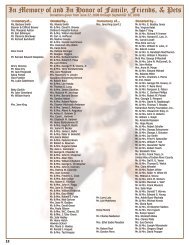Winter Edition - Humane Society of Vero Beach & Indian River County
Winter Edition - Humane Society of Vero Beach & Indian River County
Winter Edition - Humane Society of Vero Beach & Indian River County
You also want an ePaper? Increase the reach of your titles
YUMPU automatically turns print PDFs into web optimized ePapers that Google loves.
TO THEIR HEALTH...<br />
by Dr. Elizabeth M. Bybee, DVM<br />
Pet Obesity – A “Growing” Problem<br />
Almost half <strong>of</strong> the pets in the U.S. are overweight, but very<br />
few people believe that their pet has a problem. Unfortunately,<br />
pudgy pets are mistakenly called normal, and fit animals are<br />
thought undernourished. A healthy dog or cat should have an<br />
hourglass shape with a visible waist. The last two or three ribs<br />
should be palpable, yet not seen.<br />
Obesity is a concern because overweight pets are more<br />
prone to diabetes, heart disease, arthritis, skin disease, and<br />
heat exhaustion. Research has revealed that excess weight<br />
may reduce our pets’ quality <strong>of</strong> life and their longevity by two<br />
years or more.<br />
If a pet is overweight, the first step to weight reduction<br />
should include a frank family discussion to determine all food<br />
sources. This includes meals, all snacks, and any "stolen" food.<br />
A sincere commitment is required from everyone, after all it is<br />
the people who overfeed and need to change their behavior.<br />
The second step is a visit to your veterinarian. Your pet’s<br />
examination may reveal any health concerns, such as heart<br />
disease or arthritis. A blood test may be needed to rule out endocrine<br />
or metabolic disease. Your pet’s age, sex, health status,<br />
and activity level must be considered when selecting a diet.<br />
The veterinarian consultation should include a realistic goal<br />
weight, diet recommendations, feeding guidelines, and any<br />
medication or nutritional supplementation that may be helpful.<br />
Adequate, complete nutrition cannot be compromised as<br />
we reduce excess calories. Cats are especially sensitive to food<br />
changes. A safe, gradual weight loss <strong>of</strong> 1% <strong>of</strong> body weight per<br />
month is very realistic.<br />
The third step <strong>of</strong> the plan is an attitude adjustment for the<br />
"feeders" in the family. Food does NOT equal love. If a food<br />
treat is appropriate, give a piece <strong>of</strong> the treat, not the whole<br />
thing. Learn to "treat" your pet with your time and activities.<br />
They will love the attention, and the increased play and exercise<br />
will help to keep them young and healthy.<br />
80 dogs were vaccinated at the Fellsmere<br />
vaccination clinic held on August 29th<br />
Staff, volunteers, and Drs. Killpatrick,<br />
Bybee, and Soule assisted with the clinic<br />
A "cats only" vaccination clinic was held at<br />
the Shelter on October 17th<br />
by Laurie Iodice, Volunteer Cat Specialist<br />
Petting-Induced Aggression<br />
You’re sitting in your favorite chair<br />
watching TV, and kitty jumps into your<br />
lap. While repeatedly stroking her, all <strong>of</strong> a<br />
sudden you find her teeth clamped onto<br />
your hand. Ouch! What just happened?<br />
This behavior is called petting-induced aggression.<br />
You may think this attack came<br />
from out <strong>of</strong> nowhere, but it is more likely<br />
that your cat was giving you warning signs<br />
ahead <strong>of</strong> time.<br />
Most cats enjoy being petted but may<br />
have definite tolerance thresholds. Overstimulation (by repeated<br />
stroking) or contact confusion (from touching kitty as she is<br />
getting sleepy) can set your cat into survival instinct mode. She<br />
bites or scratches to get away—too much contact!<br />
You may be convinced that this behavior is totally unprovoked<br />
but your cat will give you body language<br />
signals like a thumping tail, flattened<br />
ears, rippling skin, low growling, or tense<br />
posture. From the cat’s point <strong>of</strong> view, she's<br />
been giving you plenty <strong>of</strong> notice that she is<br />
no longer enjoying being petted. You haven’t<br />
been paying attention to her warnings, so<br />
she needs to be more forceful.<br />
These are some suggestions for the best<br />
way to handle this problem: Pet for shorter<br />
periods. Try stroking your cat two or three<br />
times and stop. Use different petting motions (gliding, waving, circling,<br />
flicking, kneading, or rubbing), and stick to areas you know<br />
she likes. Sometimes lightly resting your hand on her body, with<br />
no movement, will be enough. Be conservative with your stroking<br />
and petting; always leave your kitty wanting more.<br />
5


